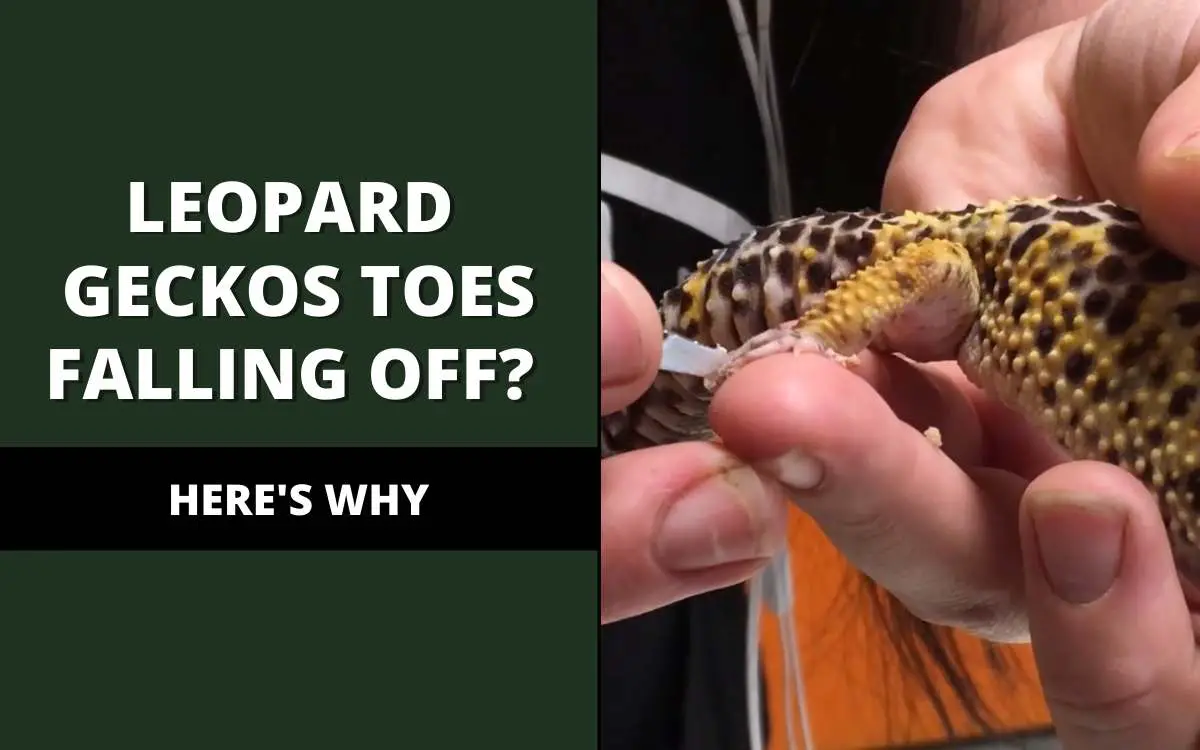Disclaimer: As an Amazon Associate I earn from qualifying purchases. Therefore, we may collect a share of sales from the links on this page, at no extra cost to you!

Leopard geckos are fascinating creatures that have several special abilities other reptiles may not. For example, leopard geckos can re-grow their tail and even blink while sleeping!
However, one quirk that leopard geckos suffer from is their fragile toes. Unfortunately, it is very common for leopard geckos to lose their toes.
This leaves many people wondering why leopard geckos lose their toes and whether or not they should be concerned.
Leopard geckos may lose their toes for a variety of different reasons. Some of these reasons include issues with their diet, housing, or even handling. However, it is not painful for your leopard gecko to lose its toes and doesn’t typically require a veterinarians assistance.
In this article, we’ll be taking a deeper looking into why leopard geckos toes fall off. Also, you’ll get more info on steps to take to prevent your leopard gecko from ever having this issue.
Jump to..
Why Do Leopard Geckos Lose Their Toes
Shedding Issues
Hide shedding could be easy for many leopard geckos. But for some of these reptiles, changing skin could be a tall order they can’t manage alone. Shedding happens at intervals throughout a leopard gecko’s life and is a natural process.
But in some cases, leopard geckos could have some tough part of their hides that don’t want to come off. These hard areas could are usually around a gecko’s feet and toes. Shedding skin in these areas could tear off flesh on a leopard gecko’s toes, leaving its bones bare. Hard shedding is the main reason why leopard geckos lose their toes.
Low Humidity
Captive leopard geckos have little say in how much humidity they can access. Leopard geckos need an atmosphere with humidity between 20 – 40% when in captivity. If the humidity in a gecko’s environment becomes very low, it may experience shedding difficulty. The end result is usually one or more lost toes after shedding.
Dry Environment
If you live in an arid area, your leopard gecko is most likely to need more moisture than in humid environments. For example, gecko owners in Nevada cannot use the same moisture requirements like a reptile handler in Hawaii.
Owners of pet geckos living in arid areas should mist the interior of their geckos’ tank frequently. Misting the tank about three to four times every day should provide your geckos the moisture they need.
Poor Feeder Insect Supplementation
Failing to supplement your geckos’ meal could affect their hide. Some leopard geckos could get squirmy hides without the right nutrients in their diet. It is important to provide your geckos enough supplements to aid their development and support easier shedding.
Steps to Save Your Leopard Geckos’ Toes
Even if you’re not a superhero (yet), there’s something you can do to help your leopard gecko keep its toes:
Moisture Provision
It is important to provide your leopard geckos enough moisture to keep them from shedding off more than their hides. You need to provide your leopard gecko regular misting and a dish of water to cool off regularly.
Frequently misting your leopard geckos’ tank enhances the chances of getting its skin off without injuries.
Humidity Monitoring and Improvement
Maintaining a humid environment in your geckos’ tank makes it easier to keep their toes. Ensure you check your geckos’ vivarium with a hygrometer at regular intervals. Several inexpensive, effective hygrometers are available on Amazon, so you don’t need to break the bank.
FAQs
What does a dying leopard gecko look like?
Signs of a dying leopard gecko
- Significant weight loss in a matter of days
- Sunken eyes
- Sustained loss of appetite
- Lethargic appearance
- Constant tip-toe movements
- Arched back
Why are my geckos toes falling off?
Shedding issues are the main reason why leopard gecko toes start falling off. Low humidity, too much heat, and dry air are other reasons why a leopard gecko could lose its toe. And whenever a leopard gecko loses its toe, it won’t grow back.
Do leopard geckos take fall damage?
Geckos do not have the build to take falls from heights. The damage some geckos could experience from a fall may be minimal, massive, or fatal. It’s best for owners to provide a safe spot for their geckos where there’s a lesser chance of falling.
How do I help my leopard gecko toe shed?
Leopard geckos will find shedding their toes much easier when you mist their tank often. Many geckos may lose their toes when their hide is too dry to encourage shedding. Keeping their tank moist is a proven way to help a gecko toe shed without losing any body part.
Final Thoughts: Leopard Geckos Toes Falling Off? (Here’s Why)
If leopard geckos toes falling off has been a cause for concern, you don’t have to worry anymore. Geckos will maintain the same level of mobility even if they’re missing a few toes. But if you need your geckos to have all their toes intact, you can’t sit idly by.
Provide your geckos the right amount of moisture required to make shedding easier. Ensure correct supplements are in your geckos’ diet and water supply. If you live in an arid region, make sure your gecko’s tank receives frequent misting sprays per day.
Keeping all conditions in place for a successful shed will keep your gecko in top shape and prevent peeling hides. You don’t want to have a gecko with flesh on several of its toes missing. Even if they can still move normally, no one wants such for their pets.
